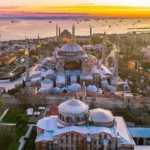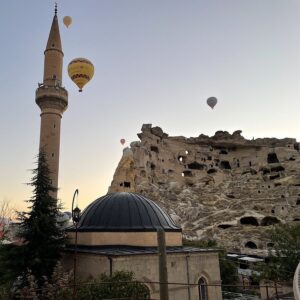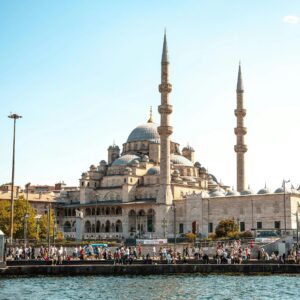Pamukkale Day Tours From Antalya offer a seamless experience to explore the iconic travertine terraces and ancient Hierapolis. You’ll travel comfortably in air-conditioned shuttles, enjoying scenic countryside views along the way. Wander through the gleaming white calcium pools, marvel at Roman ruins, and relax in Cleopatra’s thermal pool. Guided tours provide expert insights, while self-guided options allow for flexible exploration. Continue to uncover more tips and highlights for your unforgettable visit.
Key Takeaways
- Scenic drive through the Turkish countryside from Antalya to Pamukkale.
- Explore UNESCO-listed travertine terraces and the ancient city of Hierapolis.
- Relax in thermal pools with healing mineral waters, rich in therapeutic benefits.
- Guided tours include expert insights and hassle-free transportation.
- Entrance fees cover access to travertines and Hierapolis, with optional combo tickets for nearby attractions.
What to Expect on a Pamukkale Day Tour

Pamukkale, a UNESCO World Heritage Site, offers breathtaking travertine terraces and ancient ruins that you’ll explore on a day tour. Your journey begins with a scenic drive through the Turkish countryside, immersing you in the region’s natural beauty.
Upon arrival, you’ll marvel at the gleaming white terraces, formed by mineral-rich thermal waters cascading over centuries. Immerse yourself in Pamukkale history as you wander through the ancient city of Hierapolis, where well-preserved Roman baths, a grand theater, and sacred temples await. The Necropolis of Hierapolis is one of the largest ancient burial sites in Turkey, offering a glimpse into the city’s past.
Step onto gleaming white terraces, explore ancient Hierapolis, and uncover centuries of history in its Roman baths and sacred temples.
Tour itineraries often include a dip in Cleopatra’s Pool, where warm, healing waters invite relaxation. You’ll have ample time to capture stunning photos of the surreal landscape and soak in the serene atmosphere.
Knowledgeable guides will share fascinating stories, enriching your experience. Comfortable walking shoes and a camera are essential for this adventure.
Pamukkale’s unique blend of natural wonders and historical treasures guarantees an unforgettable day of discovery and freedom. The Roman Theater in Hierapolis is a must-see, showcasing the architectural brilliance of the Roman Empire.
Best Time to Visit Pamukkale

The stunning travertine terraces and ancient ruins of Hierapolis shine year-round, but timing your visit can improve the experience. The best season to explore Pamukkale is spring (April to June) or autumn (September to October), when the weather is mild and the crowds are thinner.
During these months, you’ll enjoy comfortable temperatures, perfect for walking barefoot on the warm, mineral-rich terraces or wandering through the ancient city. Summer (July to August) can be scorching, with temperatures often exceeding 35°C, making midday exploration less enjoyable. For a refreshing break, consider swimming in Cleopatra’s Pool, known for its thermal waters and submerged Roman columns.
Winter (November to March) offers cooler weather, but the terraces’ thermal waters remain warm, creating a magical contrast with the crisp air. Climate considerations are key—pack sunscreen and a hat for summer, and layer up in winter.
Visiting early morning or late afternoon guarantees softer light for photography and a more serene atmosphere. For a seamless experience, consider booking a Pamukkale day tour that includes flights, transfers, and guided visits to Hierapolis. Choose wisely, and Pamukkale will reward you with unforgettable moments.
Highlights of the Travertine Terraces

While exploring the travertine terraces, you’ll step into a surreal landscape of gleaming white calcium pools, filled with warm, mineral-rich waters that shimmer under the sun.
These stunning travertine formations, shaped over thousands of years by thermal springs, create a natural masterpiece that feels otherworldly. You can walk barefoot across the terraces, feeling the smooth, cool surface beneath your feet as you marvel at the cascading pools.
The geological significance of this site lies in its unique process of mineral deposition, which has crafted these terraces into a UNESCO World Heritage Site. Nearby, you can also explore the ancient city of Hierapolis, with its Roman Theatre and necropolis offering a glimpse into history. Don’t miss the chance to soak in the thermal waters, known for their healing properties, while enjoying panoramic views of the surrounding valley.
The interplay of light and water transforms the terraces into a photographer’s dream, especially during sunrise or sunset. This is a place where nature’s artistry invites you to pause, explore, and connect with the earth’s raw beauty.
Exploring the Ancient City of Hierapolis

Just steps from the dazzling travertine terraces, you’ll discover the ancient ruins of Hierapolis, a once-thriving Roman city steeped in history. The healing thermal waters favored by Roman emperors still flow through this historic site, adding to its allure.
Wander through the well-preserved streets, where centuries-old columns and theaters stand as silent witnesses to its past glory. The grand amphitheater, with its imposing stage and tiered seating, offers breathtaking views of the surrounding landscape.
Nearby, the Necropolis, one of the largest ancient cemeteries in Turkey, reveals intricate tombs and burial sites, showcasing the city’s cultural significance. Don’t miss the Temple of Apollo, a sacred site where ancient rituals were once performed.
Hierapolis isn’t just a destination—it’s an immersive journey into history. As you explore, you’ll feel a sense of freedom, stepping back in time to a world of grandeur and mystery. The Celsus Library in Ephesus is another stunning example of Roman architectural brilliance, much like the structures you’ll see here.
This UNESCO World Heritage Site is a must-visit for anyone seeking to connect with the past while experiencing the beauty of Turkey’s rich heritage.
Thermal Pools and Their Healing Properties

After marveling at Hierapolis’ ancient ruins, you’ll find Pamukkale’s thermal pools just a short walk away, their milky-blue waters shimmering under the sun. These natural wonders are famed for their healing benefits, thanks to the rich mineral content of calcium, magnesium, and bicarbonate.
Step into the warm, terraced pools and let the soothing waters ease muscle tension, improve circulation, and rejuvenate your skin. The travertine terraces, formed over millennia, create a surreal landscape where you can unwind while surrounded by breathtaking views.
Pamukkale’s thermal waters have been cherished since Roman times for their therapeutic properties, and today, you can experience the same restorative effects. Whether you’re seeking relaxation or relief from aches, these pools offer a unique escape. The ancient stadium in nearby Aphrodisias, one of the largest in the ancient world, is a testament to the region’s historical significance.
Don’t forget to bring your camera—the contrast of the bright white terraces against the azure waters is unforgettable. This is nature’s spa, waiting to heal and inspire you. Recognized as a UNESCO World Heritage Site, Pamukkale’s thermal pools are a must-visit for wellness and history enthusiasts alike.
Transportation Options From Antalya

Traveling from Antalya to Pamukkale offers several convenient transportation options, each with its own perks.
If you crave flexibility, a car rental is your best bet. You’ll enjoy the freedom to explore at your own pace, stopping at scenic spots like the ancient city of Hierapolis or the stunning travertine terraces. The drive takes about 3 hours via the D650 highway, offering breathtaking views of the Turkish countryside. Along the way, you can marvel at the Bouleuterion in Priene, a testament to ancient architectural ingenuity.
For a more relaxed journey, shuttle services are a hassle-free alternative. These comfortable, air-conditioned vehicles provide direct routes to Pamukkale, allowing you to sit back and enjoy the ride. Shuttles often include pick-up and drop-off at your hotel, making them a stress-free choice.
Both options guarantee you’ll arrive ready to soak in the thermal pools and marvel at the natural wonders. Choose the one that suits your travel style and embrace the adventure. For those short on time, consider a guided day tour similar to the one-day Cappadocia adventure from Istanbul.
Guided vs. Self-Guided Tours

While planning your visit to Pamukkale, deciding between a guided or self-guided tour can shape your experience.
Guided exploration offers structured itineraries, expert insights, and hassle-free logistics, allowing you to focus on the stunning terraces and ancient ruins. A knowledgeable guide can share fascinating stories about Hierapolis, the thermal pools, and the region’s history, enriching your journey. For those who appreciate curated experiences, a guided sightseeing tour ensures you don’t miss key highlights while learning about the area’s cultural significance.
On the other hand, an independent adventure lets you set your own pace, linger at scenic spots, and discover hidden gems at your leisure. You’ll have the freedom to wander the travertines, dip in the warm springs, and explore Cleopatra’s Pool without time constraints.
Both options have their charm; it depends on whether you prefer curated knowledge or spontaneous discovery. Choose guided tours for convenience and depth or self-guided trips for flexibility and personal exploration. For those short on time, a half-day afternoon tour can provide a rich experience without compromising on key highlights.
Either way, Pamukkale’s beauty will leave you in awe.
What to Pack for Your Day Trip

Pamukkale’s dazzling travertines and ancient ruins demand thoughtful preparation to make the most of your day trip.
Start by packing essential items like a reusable water bottle, sunscreen, and a wide-brimmed hat to stay hydrated and protected under the sun. Weather considerations are vital, as the region can be hot and dry; lightweight, breathable clothing and comfortable walking shoes are a must. For a seamless experience, consider booking a group shuttle transfer to ensure a stress-free journey to and from your destination.
Don’t forget a swimsuit and a quick-dry towel if you plan to dip in the thermal pools. A small backpack will help you carry snacks, a camera, and any personal items. Sunglasses and a portable charger are also handy for capturing the stunning views.
Keep a light jacket or scarf for cooler mornings or evenings. If you’re inspired by the Ottoman history of Bursa, you’ll appreciate the blend of nature and culture in Pamukkale too. With these essentials, you’ll be ready to explore Pamukkale’s natural wonders and historical treasures with ease and comfort.
Entrance Fees and Ticket Information

To make the most of your visit to Pamukkale, it’s essential to plan ahead for entrance fees and ticket options, guaranteeing a smooth and hassle-free experience. The entrance fees for Pamukkale vary depending on the season, with higher rates during peak months. You’ll typically pay around 400 TL per person, which includes access to the travertines and Hierapolis ancient city. Ticket information is straightforward, and you can purchase passes at the gate or online to skip the lines. If you’re planning to explore nearby attractions, combo tickets offer great value. Keep cash handy, as card payments aren’t always accepted. Arriving early or late in the day can help you avoid crowds and enjoy the serene beauty of the terraces. Checking the official website for updates on pricing and opening hours before your trip guarantees you’re well-prepared for your adventure. For the best experience, consider visiting during the spring when the weather is ideal for exploring outdoor sites.
Nearby Attractions to Combine With Pamukkale

Since Pamukkale’s breathtaking travertines are just the beginning, you’ll want to explore the surrounding gems that make this region unforgettable.
Hierapolis, the ancient city perched above the travertines, offers a fascinating blend of history and culture with its well-preserved theater, necropolis, and sacred pool.
For natural wonders, head to the nearby Kaklık Cave, a hidden underground marvel with stunning stalactites and thermal waters.
The Aphrodisias archaeological site, a short drive away, showcases Roman-era ruins, including a grand stadium and temple dedicated to Aphrodite.
If you’re craving more cultural experiences, visit Laodicea, an ancient city with impressive colonnaded streets and early Christian history.
Don’t miss the chance to relax in the thermal springs of Karahayıt, known for their vibrant red waters.
For a unique experience, consider a hot air balloon ride over Cappadocia, offering panoramic views of its surreal landscapes. Enhance your journey with a stay in a boutique cave hotel, blending comfort with the region’s unique charm.
These attractions, easily accessible from Pamukkale, guarantee your journey is filled with discovery and wonder.
Tips for Capturing the Best Photos

The stunning landscapes and ancient ruins around Pamukkale offer endless opportunities for breathtaking photos. To make the most of your shots, focus on photo composition by framing the terraces with natural elements like trees or the horizon.
Use leading lines, such as the cascading pools, to draw the viewer’s eye into the scene. For the ancient ruins of Hierapolis, experiment with angles to highlight the grandeur of the amphitheater or the columns.
Utilize cascading pools as leading lines to guide the viewer’s gaze; explore angles to showcase Hierapolis’s amphitheater and columns.
Lighting techniques are vital—visit during golden hour, just after sunrise or before sunset, to capture warm, soft hues that enhance the travertines’ brilliance.
Midday light can be harsh, but it’s perfect for emphasizing the stark white of the terraces. Don’t forget to adjust your camera settings or use filters to balance the brightness.
With these tips, you’ll create images that truly reflect Pamukkale’s magic.
Local Cuisine and Dining Options

Ever wondered where to savor authentic flavors after exploring Pamukkale’s terraces? Pamukkale offers a variety of dining experiences that let you immerse yourself in the region’s rich culinary heritage.
Local dishes like gözleme, a savory stuffed flatbread, and kebab platters are must-tries. You’ll find cozy family-run restaurants near the travertines, serving fresh, seasonal ingredients.
For a unique experience, try a traditional Turkish breakfast spread, complete with olives, cheeses, and honey. Many eateries feature outdoor seating, allowing you to enjoy your meal with stunning views of the terraces.
Don’t miss the chance to sip on çay (Turkish tea) or freshly squeezed pomegranate juice. If you’re adventurous, sample testi kebabı, a slow-cooked meat dish served in a clay pot.
Whether you’re craving street food or a sit-down meal, Pamukkale’s local cuisine will leave you satisfied and keen to explore more.
Sustainable Tourism Practices in Pamukkale

Though Pamukkale’s natural wonders draw countless visitors, it’s essential to explore responsibly to preserve its beauty for future generations.
Opt for eco-friendly initiatives like walking trails, solar-powered facilities, and waste reduction programs that protect the travertines. Choose responsible travel by supporting local guides who prioritize conservation over crowds.
Pamukkale’s fragile ecosystem thrives when you stick to marked paths, avoid touching the thermal pools, and use biodegradable sunscreen. Nearby, eco-conscious hotels and restaurants minimize plastic use, offering organic meals sourced from regional farms.
Public transport or shared shuttles from Antalya reduce carbon footprints, while electric bikes let you explore nearby Hierapolis sustainably. Pack reusable water bottles and respect wildlife habitats to keep the area pristine.
By embracing these practices, you’ll enjoy Pamukkale’s dazzling white terraces, ancient ruins, and hot springs without compromising their longevity.
Every small action counts—travel light, leave no trace, and inspire others to follow.
Frequently Asked Questions
Are There Age Restrictions for the Thermal Pools?
You can usually enjoy thermal pools with no strict age limitations, but some spots enforce thermal pool rules—like minimum heights or adult supervision for kids. Check specific policies to guarantee unrestricted, worry-free relaxation for everyone.
Can I Bring My Own Food and Drinks?
Of course, you’re free to bring all the picnic options you want—until you read the food regulations! Pack a feast, but don’t be surprised if they say “enjoy it outside the pools.” Rules, right? Always cramping your style.
Is There Wi-Fi Available at Pamukkale?
You’ll find limited Wi-Fi access at Pamukkale, so don’t rely on it for constant internet availability. It’s best to enjoy the natural beauty and freedom of the area without being tied to your devices.
Are Pets Allowed on the Tour?
You crave adventure, but your furry friend stays behind—most tours don’t allow pets due to pet friendly policies prioritizing animal welfare. Check specific operators; some may welcome small pets if they’re secured and well-behaved.
What Is the Cancellation Policy for Tours?
You can cancel your tour, but check the refund process for details. If you need tour changes, notify them early to avoid fees. Flexibility’s key, so review policies to guarantee you’re free to adjust plans.












